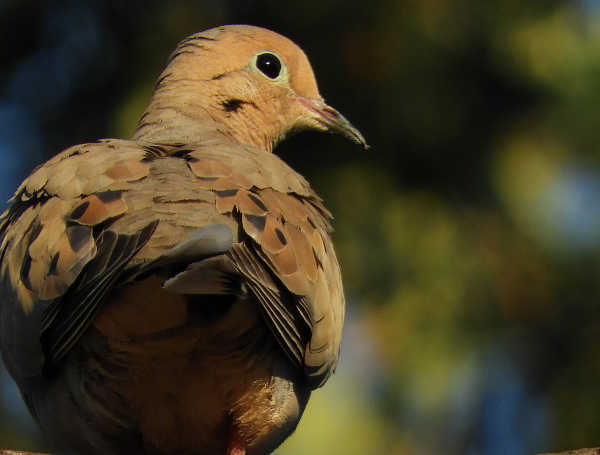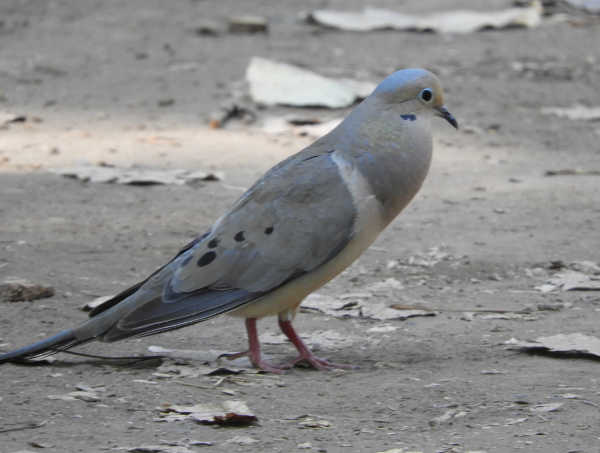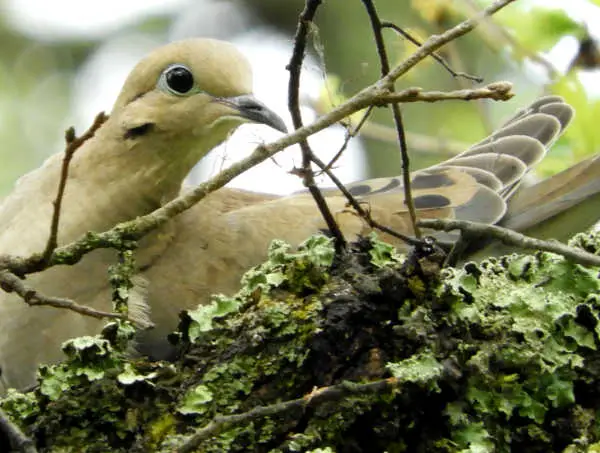
Coo-hoo-woo-woo-woo. It’s an easily recognizable sound.
The gentle cooing of the Mourning Dove (Zenaida marginella) is most often performed by the male of the species when he’s courting a female or reestablishing a bond with a mate. The doves are generally monogamous, especially if they don’t participate in any form of migration.
Some individuals migrate, others do not. (Some have actually shown up in Canada and Great Britain!) It’s very often the availability of food sources that determine their migration status.
So, keeping platform-type bird feeders available to them in your yard or garden year-round will encourage them to stay. Bear in mind that the doves eat most often from the ground, so if you have feeders around, keep your cats indoors.
The mourning doves will on rare occasions eat garden snails, but otherwise their diet consists exclusively of different kinds of seeds.
Usually, they’ll gobble up as many seeds as they can in a single seating and store them in their crop, a muscular pouch-like expansion of the esophagus. Once the crop is full, the dove will fly off to a secure area to rest and continue with the digestion process.
The exception to the 99-percent-seed diet applies to the doves’ young, called “squabs.” The newborns cannot digest seeds, so for the first few days of their lives, the parents feed them “crop milk,” a special gooey secretion the parents regurgitate for them.
The cottage-cheese-looking milk is high in protein and fat, but it lacks carbohydrates or calcium. Both the males and the females, who co-parent the young, can produce the milk which along with nutrition, provides the baby birds with the immune-building antibodies they need to survive and grow.
What’s additionally fascinating about the milk is that it appears in the adults a day or two before the eggs hatch, so it’s ready for the squabs as soon as they need it.
When the squabs are old enough to eat seeds, the parents’ milk gradually shuts itself off. Doves aren’t the only birds that produce the crop milk; some species of pigeons and flamingos do, too, as do male emperor penguins.

Not only do both mourning dove parents feed their young, both parents also incubate the eggs, so often you’ll find the male sitting on the nest.
Like many birds, male mourning doves have coloring the females do not, but much of their extra color is somewhat subtle. The males’ breast and neck have a somewhat pink hue to them, and the top of the head bears a grayish blue cap. Otherwise, the sexes look very much the same.
Mourning doves are one of the most common and abundant species of bird in the country, even though they are hunted regularly, and this is due in part to the fact that the birds are highly adaptable and can have up to six broods in a single year.
Egg-laying can last from mid-February to early October; more than any other bird. Usually, each brood consists of two eggs which are laid in a nest that often looks too thin and flimsy to contain them.
The doves aren’t the greatest architects when it comes to nest construction. Males usually scout out nesting sites – usually a branch with foliage around it or some flat surface that has some form of protection on at least one side – and then he escorts the female around to the sites until she chooses one she likes.
While the female sits on the spot she like best, the male will go in search of fine twigs and grasses and carry them to her to arrange as she pleases.
At each landing and takeoff, you’ll hear a bright whooshing-whistling sound emanating from the dove. This isn’t made by the bird’s vocal equipment; it’s made by the air rushing through the doves’ feathers. Mourning doves are actually strong flyers and can reach speeds up to 55 mile per hour.
You can help the doves with nesting sites by providing them with simple wire- or twig-mesh nesting cones in the trees around your house or property.
The construction of these cones is simple enough for children to produce, and detailed instructions including the optimal places to secure the cones can be found online at Nest Watch.
Mary K. Hanson is a Certified California Naturalist, author and nature photographer, living with terminal cancer. She developed and helps to teach the naturalist program at Tuleyome, a 501(c)(3) nonprofit conservation organization based in Woodland. For more information, see their website at http://tuleyome.org/.


 How to resolve AdBlock issue?
How to resolve AdBlock issue? 





